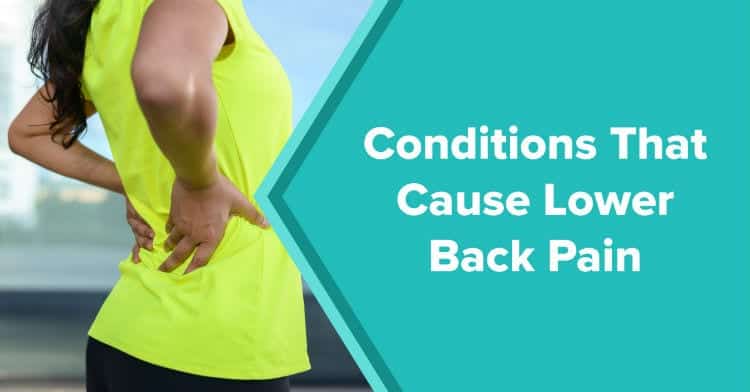The majority of people (80 percent) will experience lower back pain in their lifetime, which leads to people spending at minimum $50 billion per year related to back pain, according to the American Chiropractic Association. The odds that you will experience at least one of the lower back conditions at some point in your lifetime are relatively likely, and the pain can be a nagging nuisance or in some cases, debilitating. It is important to educate yourself on the different types of lower back pain conditions.
Lower back pain is a general term that covers a lot of different conditions and types of pain. The various types of pain are grouped into three distinct categories including:
- Axial pain. Axial pain is related to a particular muscle or muscle group. The pain can be transient or consistent, sharp or dull. Muscle strain is the most common cause of axial pain in the lower back.
- Radicular pain. Radicular pain is most often a severe type of pain that travels along the path of a nerve. For example, you may feel a shooting pain that moves along your spine and down through your arm. A feeling of numbness or tingling may accompany this type of pain.
- Referred pain. Referred pain tends to be a dull, migratory ache. The pain can move from your lower back to your hip and buttock. This type of pain earns its name because the pain is felt in a place other than the source.
Each of these types of pain can have different causes. Here are 11 causes of pain the lower back to know.
Osteoarthritis
Osteoarthritis is a type of arthritis that affects the spinal discs – the tissue that acts as cushions that separate the vertebrae. There are 23 vertebral discs in your spine, according to Spine-Health, but osteoarthritis tends to affect the discs in the lower back. This condition can have an impact on a single disc or multiple discs.
Osteoarthritis tends to develop in individuals who are 40 years or older. This condition can be a cause of lower back pain in as much as 20 percent of 40-years-olds, while it could be the cause of back pain for up to 75 percent of people 60 years and older, according to the Arthritis Foundation.
Osteoarthritis can decrease your spine’s stability and lead to the growth of bone spurs. As you age, you might develop osteoarthritis but feel no symptoms. When osteoarthritis does cause pain, it is because the increasingly unstable spine is putting pressure on the spinal cord and nerves.
Exercise is the first treatment any physician will recommend for osteoarthritis. You can also use anti-inflammatory drugs like ibuprofen to help control discomfort caused by inflammation and if pain persists, surgery may be an option. Surgical treatments include spinal fusion, which halts movement at the painful joint and laminectomy, which involves the removal of a piece of bone that is causing pressure on spinal nerves.
Fracture
Osteoporosis weakens our bones, which can make them more susceptible to breaks. Fractures in the spine caused by osteoporosis are known as compression fractures. If a compression fracture is the source of your lower back pain, the pain will most likely be sudden and sharp. Osteoporosis can affect other areas of the body, including the hips and wrists, but spinal fractures are the most common type of fracture related to this condition. Every year, approximately 700,000 patients experience a spinal compression fracture associated with osteoporosis, according to the American Academy of Orthopedic Surgeons.
Physicians will likely order a bone density test to determine the extent of damage done by the osteoarthritis’s progression. The results of this test can also help your doctor predict your risk level for future fractures related to osteoarthritis.
Depending on the severity of the fracture, you might not need any surgical intervention. If the fracture needs to be addressed, the two options include:
- Kyphoplasty. Kyphoplasty involves inserting a small device that creates space between the damaged vertebrae. The procedure is designed to relieve back pain by restoring the vertebra to its pre-fractured height. While kyphoplasty is an option, its efficacy is still debated.
- Vertebroplasty. During vertebroplasty, a type of medical cement is injected into the fractured vertebra. This procedure is also designed to relieve the pain caused by a fracture. Like kyphoplasty, the efficacy of this method is debatable in comparison to more conservative approaches.
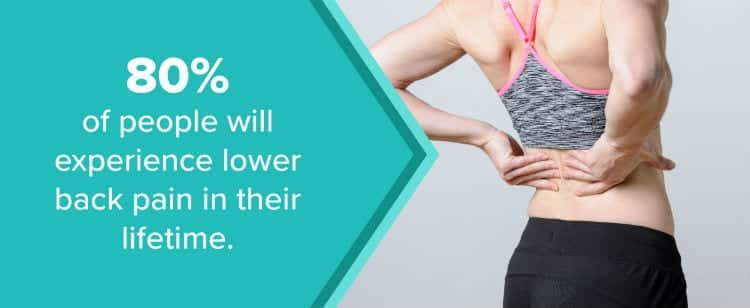
Trauma
Lower back pain followed by any trauma should be evaluated by a medical professional. Types of trauma include a car accident, a fall or an injury incurred while playing sports. The type and severity of the lower back injury will vary based on the traumatic incident. It is possible the pain is caused by something as simple as strain or something as serious as a compressed spinal nerve. Treatment for lower back pain for trauma can range from physical therapy and bed rest to surgical intervention.
Muscle Strain
Muscle strain, while painful, is one of the least severe and most common causes of pain in lower back. The most common causes of a muscle strain in the lower back are:
- Bad posture. Bad posture is an easy habit to start. It might feel better to slouch forward at your desk during the day, or it might seem natural to stand with slumped shoulders. But, over time this type of behavior puts strain on the muscles in your back. This pressure can cause significant pain.
- Heavy lifting. You have probably heard the advice to lift with your legs instead of your back. This means that you should squat down and slowly straighten your legs as you lift. You increase the risk of hurting your back if you bend from the waist and attempt to use your back muscles to lift a heavy object. If you hurt your back after lifting something heavy, it is likely due to an acute muscle strain or small tears in the ligaments in your lower back.
- Overuse. The muscles in your back are like anything else in your body. They need to be trained to take on heavy use. If you haven’t played sports for years, but decided to join a recreational league, you are going to be putting a lot of strain on muscles that haven’t been asked to perform that much in a long time. Similarly, jobs that require strenuous physical activity can result in muscle strain from overuse.
Simple at-home exercises can help you prevent lower back muscle aches and strains. If you have a more severe muscle strain, your doctor might recommend physical therapy to address the pain.
Herniated Disc
When one of the discs that separate your spinal vertebrae slips or ruptures, this is known as a herniated disc. When this occurs in the lumbar spine or lower part of your spine, you will feel the pain in your lower back and your leg. You can feel numbness or tingling that begins in your leg and travels all the way down to your foot.
A herniated disc can be caused by a number of issues, but the most common reason is aging. Other risk factors include smoking, obesity, prolonged periods of sitting, repetitive strain on your spine and lifting heavy objects incorrectly.
Most herniated discs do not require surgical intervention. Instead, your physician will suggest rest, anti-inflammatory medications and exercise. Sometimes steroids can be injected directly into the back to help reduce the pain and inflammation caused by the slipped or ruptured disc.
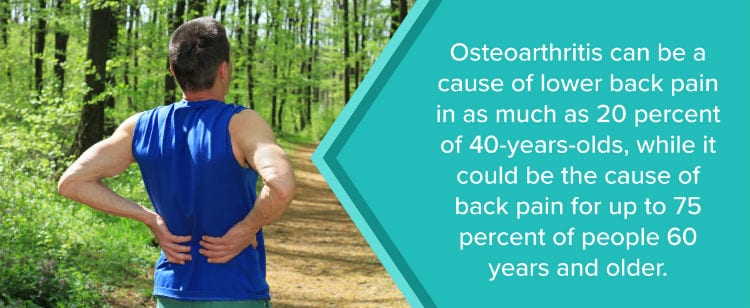
Degenerative Disc Disease
Degenerative disc disease is sometimes one of the conditions that are associated with lower back pain symptoms. Other times, degenerating discs, a natural occurrence that comes with age, does not cause any pain at all. Degenerative disc disease is not considered a disease – rather it is a general term that refers to wear and tear on the spinal discs.
Degenerative disc disease can be the result of osteoarthritis, activities that put strain on your spine, and acute injury. Once damaged, discs are incapable of self-repair. This means an injured disc will begin to degenerate. Degenerative disc disease can occur anywhere in the spine, but it is most likely to affect the lower back or the neck.
Exercise is the first line of treatment for the pain caused by a form of degenerative disc disease because exercise helps strengthen the muscles that support your spine. Your physician might also prescribe physical therapy and anti-inflammatory drugs.
If nonsurgical treatments are not effective, degenerative disc disease might be treated with:
- Artificial disc replacement. During artificial disc replacement surgery, a medical device is placed in the spine to do the original disc’s job. The procedure might be a total disc replacement or a disc nucleus replacement, which involves replacing just the center of the natural disc.
- Spinal fusion. Lumber spinal fusion is another surgical option. This involves fusing the area of the spine with the painful discs. Stopping the discs’ movement is meant to stop the pain it causes.
Radiculopathy
Radiculopathy refers to compression or injury that affects the spinal nerve root. This type of lower back pain tends to be steady and made worse by certain postures or activities. The pain is usually accompanied by a numb or tingling sensation that travels the path of the affected nerve.
A herniated disc can result in radiculopathy. Other potential causes include diabetes, scar tissue from a prior surgery and nerve root injuries.
The more conservative approach to lower back pain will be applied in cases of radiculopathy before moving on to surgical intervention. Surgical options include:
- Discectomy. During a discectomy, a surgeon will remove the injured portion of a spinal disc.
- Laminectomy. Laminectomy, also known as decompression surgery, involves the removal of part of the vertebra. Removing this piece of bone widens your spinal canal, allowing more space and decreasing pressure on the spinal nerves.
Sciatica
Sciatica is a type of radiculopathy. Sciatica can affect one or both sciatic nerves, which run from your lower back through your posterior and down each leg. People who suffer from sciatica may feel more pain in the leg than the lower back. In most cases, sciatica is an indication of another spinal issue such as a herniated disc or age-related degenerative disc disease. Some people experience worsening pain when sitting down.
Depending on the cause of sciatica, more conservative treatments may be appropriate. Alternatively, your physician might consider surgical options like laminectomy or discectomy.
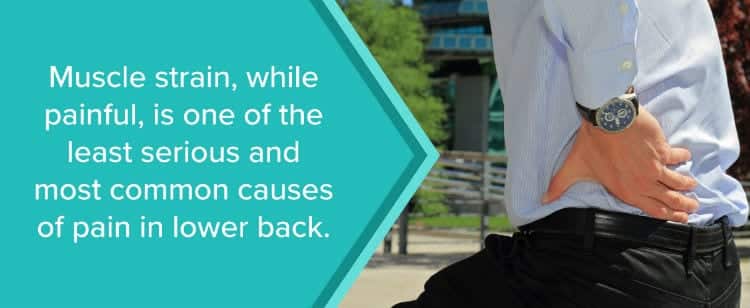
Scoliosis
Unlike many of the other common causes of lower back pain, scoliosis is not caused by injury or age. Instead, scoliosis is a curvature of the spine. Some cases are congenital (you are born with it), and other cases are idiopathic (the cause is unknown). Adolescent idiopathic scoliosis is the most common type of scoliosis, but both children and adults can experience this spinal deformity. Certain conditions, such as muscular dystrophy, can also lead to scoliosis.
The severity of scoliosis can vary from a slight curve to a debilitating curve. In some cases, the curve can be severe enough to cause uneven shoulders, uneven hips and a twisted spine. Left untreated, scoliosis can result in lower back pain, amongst many other symptoms.
In the case of adolescent scoliosis, a physician might recommend a back brace, which will help prevent the progression of scoliosis and spinal curvature. In severe cases, surgery such as spinal fusion may be indicated.
Spinal Stenosis
Spinal stenosis refers to a narrowing of the natural spaces in your spine. This narrowing can put pressure on the spinal nerves causing pain. Spinal stenosis can be the underlying cause for radiculopathy or sciatica. Spinal stenosis most often affects the cervical vertebrae (your neck) and the lumbar vertebrae (your lower back).
Symptoms of lumbar spinal stenosis can include lower back pain, numbness and tingling that travels down the leg, and weakness in the leg or even the foot. Stenosis can be a complication from age-related osteoarthritis. The condition can also be caused by acute injury, a tumor or herniated discs.
Spinal stenosis symptoms range from mild to severe. Mild cases will be treated with conservative approaches like physical therapy and medication. Your physician may also recommend steroid injections to address inflammation. When traditional methods fail, the next step will be decompression procedures such as percutaneous image-guided lumbar decompression (PILD) and minimally invasive lumbar decompression (MILD). Surgical treatments may include laminectomy and laminotomy, which involves the removal of just a portion of the lamina.
Spondylolysis and Spondylolisthesis
Spondylolysis refers to a stress fracture that affects a small portion of a vertebra that connects upper and lower facet joints. The fifth vertebra in the lumbar spine (lower back) is the most common place for spondylolysis. This type of injury is most often seen in children and teenagers, but it can happen during any stage of life.
If unaddressed spondylolysis can lead to spondylolisthesis, which occurs when one vertebra slips out of position and ends up over another vertebra. The most common symptom relating to these conditions is simply lower back or leg pain.
If unaddressed spondylolysis can lead to spondylolisthesis, which occurs when one vertebra slips out of position and ends up over another vertebra. The most common symptom relating to these conditions is simply lower back or leg pain.
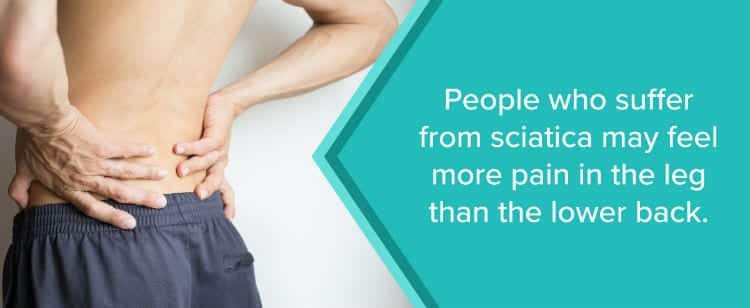
Take care of your lower back conditions
Lower back pain can have a significant impact on your quality of life. While you may know more about the different causes of pain in the lower back, you should always schedule a consult with a physician who knows how to treat the conditions that could be responsible for your back pain. A trained, board-certified physician will determine the cause and work with you to build a treatment plan.
At NJ Spine and Orthopedic, Dr. Katzman and his team have over 50 years of experience and are innovators in the minimally invasive spine field. We treat people, not patients and we can’t wait to hear from you to talk about your treatment options.

